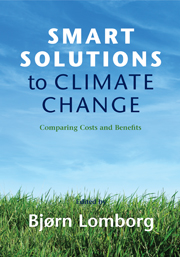Book contents
- Frontmatter
- Contents
- List of figures
- List of tables
- List of contributors
- Acknowledgments
- List of abbreviations and acronyms
- Introduction
- PART I THE SOLUTIONS
- 1 Climate Engineering
- 2 Carbon Dioxide Mitigation
- 3 Forestry Carbon Sequestration
- 4 Black Carbon Mitigation
- 5 Methane Mitigation
- 6 Market- and Policy-Driven Adaptation
- 7 Technology-Led Climate Policy
- 8 Technology Transfer
- PART II RANKING THE OPPORTUNITIES
- Conclusion
- Index
- References
6 - Market- and Policy-Driven Adaptation
Published online by Cambridge University Press: 05 June 2012
- Frontmatter
- Contents
- List of figures
- List of tables
- List of contributors
- Acknowledgments
- List of abbreviations and acronyms
- Introduction
- PART I THE SOLUTIONS
- 1 Climate Engineering
- 2 Carbon Dioxide Mitigation
- 3 Forestry Carbon Sequestration
- 4 Black Carbon Mitigation
- 5 Methane Mitigation
- 6 Market- and Policy-Driven Adaptation
- 7 Technology-Led Climate Policy
- 8 Technology Transfer
- PART II RANKING THE OPPORTUNITIES
- Conclusion
- Index
- References
Summary
Introduction
Adaptation to climate change has become a strategic negotiation issue only recently, although the UNFCCC has referred to it in Article 2 and Article 4. The difficulty of implementing national and international mitigation policies and the increasing awareness of climate inertia eventually put adaptation under the spotlight of science and policy. The EU released a Green Paper on Adaptation (European Commission 2007b) and many EU countries have prepared and started to implement national adaptation plans. The Bali action plan adopted at the December 2007 conference has identified the need for enhanced adaptation action by the Parties of the Convention, and adaptation is among the five key building blocks for a strengthened response to climate change. COP 13 has established the Adaptation Fund Board with the role of managing the Adaptation Fund, established at COP 7. COP 14, held in Poznán in 2008, also made some progress on a number of important issues concerning adaptation.
The ultimate question that interests policy makers is how to reduce the climate change vulnerability of socioeconomic systems in the most cost-effective way. This objective can be achieved with both mitigation and adaptation. It also requires, on the one hand, a thorough knowledge of the size and the regional distribution of damages and, on the other hand a precise assessment of the cost-effectiveness of alternative policies.
Given its local- and project-specific nature, a cost-benefit analysis (CBA) of adaptation strategies has been treated from a micro-perspective.
- Type
- Chapter
- Information
- Smart Solutions to Climate ChangeComparing Costs and Benefits, pp. 222 - 291Publisher: Cambridge University PressPrint publication year: 2010
References
- 4
- Cited by

